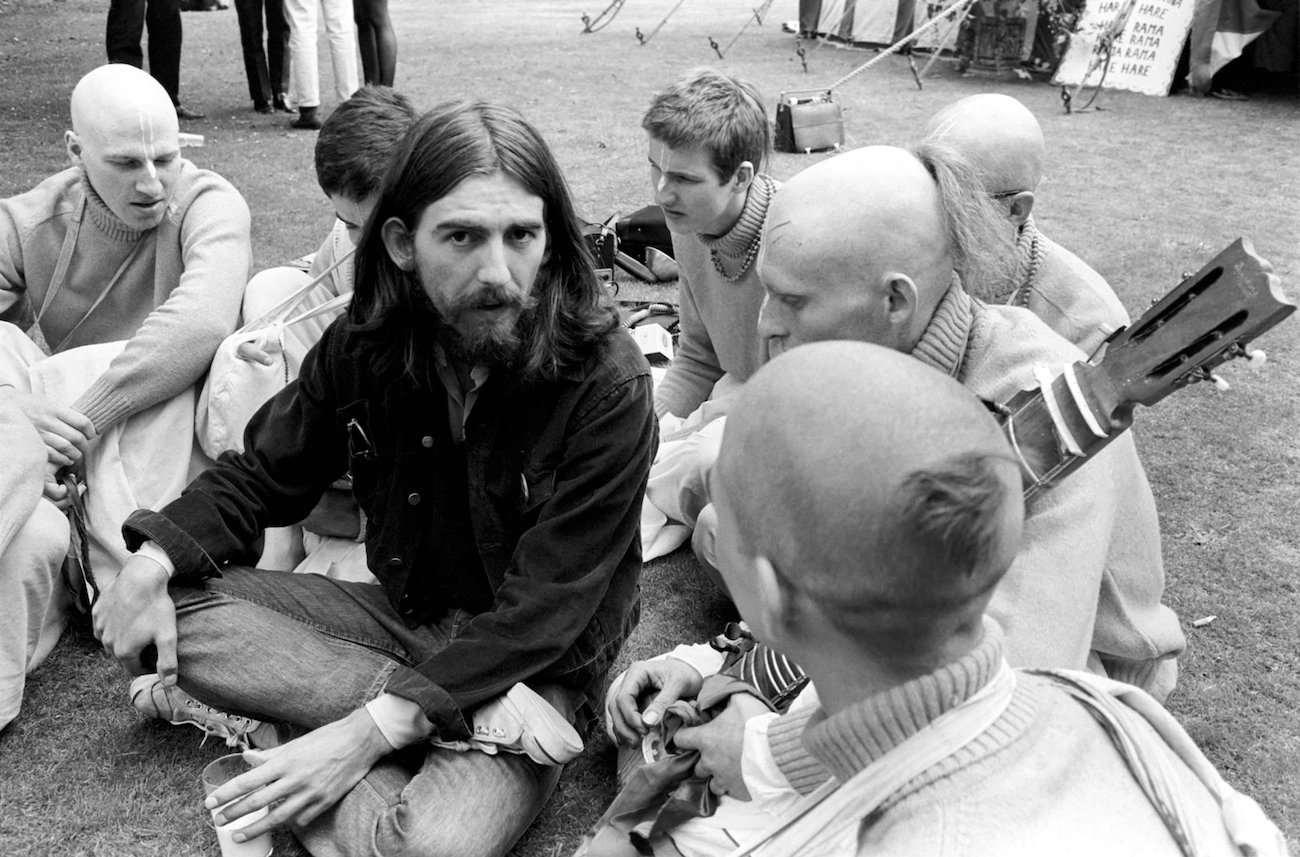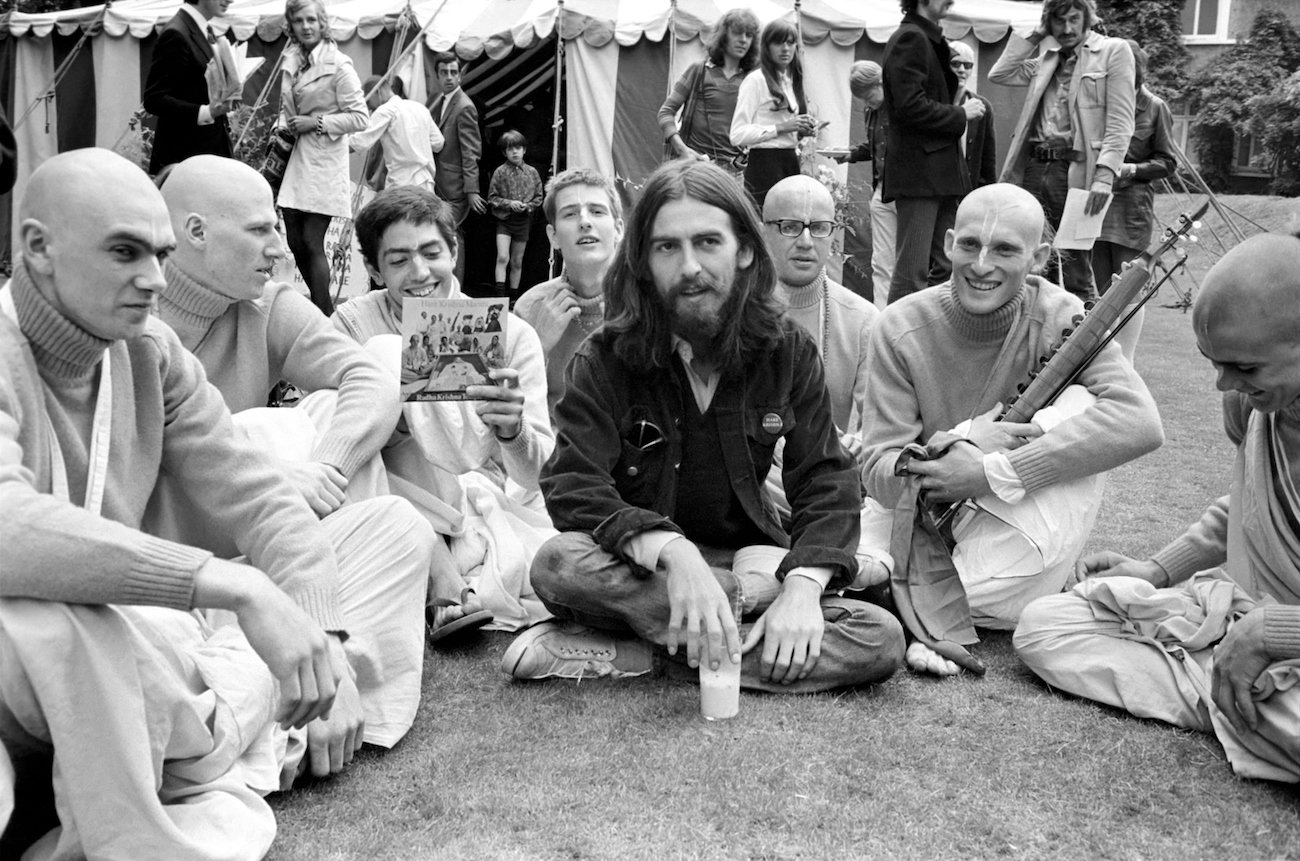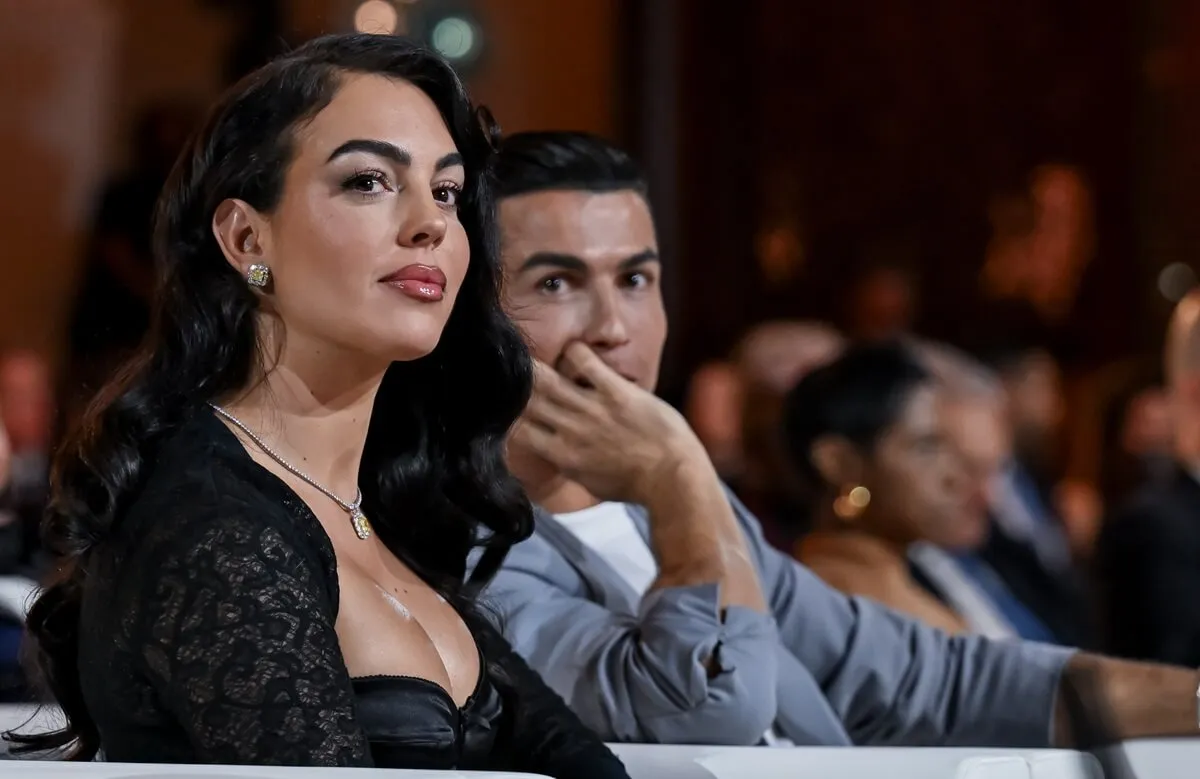
A Strange Occurrence Happened When the Hare Krishna Temple Asked George Harrison for Money
Something strange happened when a member of the Hare Krishna Temple asked George Harrison for money to publish a book. George had helped the temple establish itself in London. So, they felt awkward about asking him for more help and, this time, money. However, Krishna helped them.

The Hare Krishna Temple amazed George Harrison
In the mid-1960s, George had become disenchanted with many things, including fame. As a Beatle, George had met all sorts of celebrities and dignitaries, but no one impressed him. He’d recently taken LSD with John Lennon too. The hallucinogen had opened a door to a place unknown to George. Soon, all George cared about was seeking the tools he needed to break through that door.
Thankfully, George met Ravi Shankar, who gave him religious texts and his first sitar lessons. The legendary sitar player was the first person that wowed him. According to Quartz India, George said, “Ravi was my link into the Vedic world. Ravi plugged me into the whole of reality.”
In 1967, George purchased an album of mantras by Swami A. C. Bhaktivedanta. He played it on the boat he and John sailed on through the Greek Islands. They chanted the mantras for hours until their jaws ached. Shortly after, George traveled to San Francisco’s capitol of love, Haight-Ashbury, hoping to find liked-minded spiritualists. He was dismayed by what he saw; hypocritical hippies who were bums.
However, San Francisco did have what George was looking for; he just didn’t know it. There was a Hare Krishna Temple in Haight-Ashbury. The temple housed devotees of Bhaktivedanta Swami, a.k.a. Prabhupada, whose album George and John had listened to in the Greek Islands.
George returned to London and heard Maharishi Mahesh Yogi speak. The Beatles then attended Maharishi’s retreat at his ashram in Rishikesh in 1968.
George learned that meditation beckoned God-consciousness just as much as chanting mantras. Later, a devotee named Shyamsundar, who was part of the Haight-Ashbury temple, crashed The Beatles’ Christmas party in 1969.
He met George and told him that he and a couple of devotees from Haight-Ashbury were living in a warehouse in Covent Garden and hoped to establish a temple for Krishna in London. George invited Shyamsundar to dinner, and they talked about spiritual matters.
Then, the devotee invited George to the warehouse where he and the rest lived and worshipped. Later, Shyamsundar visited The Beatles during the filming of Let It Be, a tense period for the band. He tried to ease their conflict with each other but failed. The Beatles broke up in 1970.
George later had his new friends over for dinner and suggested they make an album of chants as their guru had done.
Something strange happened when the Hare Krishna Temple asked George for money
Later, George went on to produce The Radha Krishna Temple. According to Joshua M. Greene’s Here Comes The Sun: The Spiritual And Musical Journey Of George Harrison, Apple Records released one of the mantras, “Hare Krishna Mantra,” with “no idea how the public would react to a Sanskrit prayer set to a rock drumbeat.”
Astonishingly, the song received positive reviews and steady airplay in the U.K. It sold 70 thousand copies on the first day of its release. In two weeks, it became a No. 1 hit. It helped the temple’s cause tremendously.
Then, John allowed the devotees to stay at his Tittenhurst estate, and eventually, their guru, Prabhupada, came to stay. John and George enjoyed picking his brain. The guru explained he was translating the Bhagavad Gita, entitled As It Is, meaning without interpretation.
“Vivekananda said that books and rituals and temples are secondary details, anyway,” George said. “He said they’re not the most important thing. You don’t have to read the book in order to have the perception.”
Prabhupada agreed. “Actually, one who chants Hare Krishna regularly doesn’t require to read any books. Just like Chaitanya Mahaprabhu,” he said.
The guru referred to the sixteenth-century avatar who brought the chanting of Hare Krishna to the streets of Bengal.
“A lot of people say, ‘I’m it. I’m the divine incarnation. I’m here, and let me hip you,” George told Mukunda. “But Prabhupada was never like that. . . . I always liked his humbleness and his simplicity: ‘the servant of the servant of the servant’ is really what it is, you know. None of us is God. We’re just his servants.”
Then, in December 1969, Prabhupada moved from John’s estate to a building off Oxford Street that would become London’s Radha Krishna Temple. George signed the lease as guarantor. Even though George wasn’t initiated into the temple, the guru encouraged George to carry on serving Krishna. George commissioned the temple’s marble altarpiece.
Later, Prabhupada began writing KRSNA Book. When Shyamsundar saw the book’s hundreds of pages, he knew what his guru would ask him.
“Kindly ask George to publish this book,” Prabhupada said. “It will cost nineteen thousand dollars to print five thousand copies, with fifty-four color pages.”
“Shyamsundar’s shoulders slumped and he stared at his hands,” Greene wrote. “Nineteen thousand dollars might not have been a lot of money to someone as wealthy as George, but there was a higher principle involved.
“‘Swamiji, we must be very careful with George. We never ask him for anything. We just try to give to him, not take anything from him. If he gives, it’s something he offers on his own.'” Prabhupada understood.
“From the outset of his mission in the West he had followed the same formula, giving people chanting and instruction and never asking for payment,” Green continued. “Nor was he asking for any payment now from George. This was a unique opportunity to bring an important scripture to Western readers and he was extending a chance for George to take part.”
“You may inform George that it is my personal request. You will see. Krishna will help you to say it,” the guru said. Days later, Shyamsundar, sculptor David Wynne, and George had dinner during a storm.
Somehow, the devotee conjured up the courage to ask George about funding the book during the dinner.
“George,” Shyamsundar said abruptly, “do you remember I was telling you about that book Prabhupada wrote, KRSNA Book? He was saying that now everyone is hearing Krishna’s name, but no one knows anything about Krishna’s pastimes or what he looks like. That’s what ‘KRSHNA Book’ is about.”
Then, George started to think his friend might be turning out like so many who wanted something from him. “Prabhupada asked me to ask you something,” Shyamsundar said. He took a breath and rushed through his question.
“He wants you to publish KRSNA Book, nineteen thou-sand dollars for five thousand copies with lots of color paintings and—”
“At that moment the houselights blazed hot, then exploded—like bursts from a strobe,” Greene wrote. “The house shook. Lightning had hit the roof. Everything went black. The darkness continued for several long moments. Then just as abruptly, power returned. George leaned back in his chair, eyes wide, grinning from ear to ear.”
“Well,” he said to Shyamsundar, “there’s no arguing with that, is there?” Shyamsundar admitted, “Prabhupada said Krishna would help me, but that was a little much.”
‘KRSHNA Book’ has been translated into 20 languages
George didn’t just show the Western world “minority music.” The London Hare Krishna Temple has George to thank for helping them, including publishing a book that explained Krishna more thoroughly than ever.
Greene wrote, “Over the next thirty years, KRSNA Book would be translated into twenty languages and sell more than five million copies. In 1970, it seemed as if everything George touched turned to gold. Whether it was an ancient Sanskrit mantra that he transformed into a top ten hit or an esoteric devotional scripture that he helped make a best seller, the greater the challenge, the farther he advanced on his spiritual journey.”
However, George helped his friends because he thought it was what Krishna wanted. He also wanted to know more about spirituality and was willing to pay more than anyone else in the world for answers.


